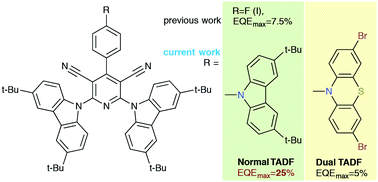A procedure for post-functionalization by 3,6-di-tert-butyl-carbazole or 3,7-dibromophenothiazine of dicyanopyridines was developed. Pyridine rings in new pyridines exist in a twist-conformation in the solid state. Green and orange thermally activated delayed fluorescence (TADF) with close emission quantum yields in solid-state resulting from recombination of two different intramolecular charge transfer (ICT) states was observed for compounds post-functionalized by 3,6-di-tert-butyl-carbazole and 3,7-dibromophenothiazine moieties, respectively. Non-doped and doped organic light-emitting diodes exhibiting green and orange electroluminescence were developed using the synthesized compounds as normal/dual TADF emitters. The device based on 3,7-dibromophenothiazine-containing emitters exhibiting dual TADF showed low device life-times and a low maximum external efficiency of 3.1 (for the non-doped device) and 5% (for the doped device). Organic light-emitting diodes with 3,6-di-tert-butyl-carbazole-containing emitters exhibiting normal TADF showed relatively high device life-times and a high maximum external efficiency of 8.1 (for the non-doped device) and 25% (for the doped device). Because of the energy distribution between the two ICT states in dual-TADF emitters, ultra-long lifetime of fluorescence (up to milliseconds) was detected which results in exciton–exciton and exciton–polaron annihilations under electrical excitation and low stability and efficiency of the device.

